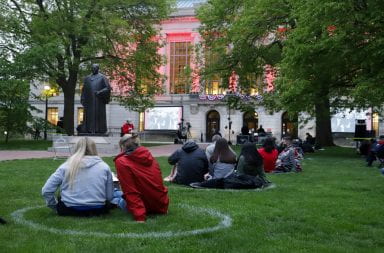
Students stand in line at the new Buckeye Bike Hub outside the RPAC waiting to get their bikes fixed on Sept. 10. Credit: Amal Saeed | Photo Editor
The scarlet and gray goes scarlet and silver with its new biking status.
After applying two times — once in 2011 and again in 2015 — for bicycle-friendly status, Ohio State has increased its status from a bronze-level campus to a silver-level campus, according to a press release from League of American Bicyclists.
The national organization recognizes colleges and universities for promoting and enabling safe, accessible bicycling on campus, according to a release on Thursday. The league measures all applicants on five major categories, including engineering, education, encouragement, enforcement and evaluation and planning.
According to the League of American Bicyclists’ website, the Bicycle Friendly University program aims to inspire colleges and universities to incorporate bike-share programs, bike co-ops, clubs, bicycling education classes and policies to promote bicycling as a preferred means of transportation.
John Shrader, field logistics coordinator for the Department of Transportation and Traffic Management at Ohio State, said the bicycle-friendly program — which is part of the Bicycle Friendly America program and run by the League of American Bicyclists — started giving out bicycle-friendly awards in 2011. That same year, Ohio State applied for recognition and would receive its first of two bronze awards.
“You apply every four years or sooner if you have significant improvements, so we applied again in 2015 and were also awarded the bronze-level recognition, and in 2019, we applied again, and we are now a silver-level bicycle-friendly university,” Shrader said.
Shrader said the bicycle-friendly awards are platinum, gold, silver and bronze, and currently there are only eight platinum universities; in the Big Ten alone, there are only two — Minnesota and Wisconsin. According to the League of American Bicyclists, 62 universities nationwide have silver status.
In addition to the recognition, the university also receives technical assistance, tools and resources to “create a great campus for bicycling” as well as connections to other bicycle-friendly universities, Shrader said in an email.
Shrader added that he and Transportation and Traffic Management worked with the Office of Administration and Planning; Planning, Architecture and Real Estate; the Office of Student Life; the Department of Public Safety; Facilities Operations and Development; Undergraduate Student Government; and other student groups and classes to gather information and data on how to improve the biking atmosphere.
Shrader said he thinks the new on-campus Buckeye Bike Hub — a central location on campus where students can bring their bikes to be repaired — had a big impact on the university’s new status.
“One of the suggestions from our 2015 feedback report was to create a bike center on campus, and they gave us examples of other universities, and we really took that to heart,” Shrader said.
One of those examples is the University of Minnesota’s bike center, Shrader said.
He said the university sees the bike hub and the Student Life staff who operate it as a huge advancement for the campus.
The university’s promotion of bicycling also helps meet its sustainability goals, Beth Snoke, director of Transportation and Traffic Management, said in the release. These goals include reducing the carbon footprint of university vehicles by 25 percent by 2025 and creating a park centered around connectivity through public transit that includes buses, bicycles, scooters and pedestrian-friendly pathways, according to the release.
“We have more than 100,000 people on campus each day, and our transit network is designed to allow community members to travel quickly and easily without having to move their vehicle for each class change or new appointment,” Snoke said.
Snoke said safety and sustainability remain the university’s top priorities, and earning a silver rating speaks to the ongoing enhancements that continue on campus.
According to the release, Ohio State is currently updating its third Comprehensive Transportation and Parking Plan with all modes of travel being considered as part of the long-term planning process.
“As the university campus physically changes, the campus is becoming more dense and more centered east of the Olentangy River between High Street, and as such, we really want to address a lot of transportation issues,” Shrader said.


